The legendary Yellowstone supervolcano captures our imagination, unlike any other geological phenomenon.
This sleeping giant has the power to dramatically impact life across the entire planet if it were to erupt, making understanding its science and myths critically important.
In this comprehensive guide, you’ll discover the key things you need to know about Yellowstone’s fascinating geology. Covering everything from the volcano's explosive past to current monitoring efforts, this article explores:
- The science behind supervolcanoes
- Yellowstone's unique geological features
- The history and impact of past massive eruptions at Yellowstone
- How scientists track Yellowstone’s activity
- The potential consequences and likelihood of future super-eruptions
- Common myths about the Yellowstone volcano
The more we can comprehend Yellowstone’s behavior, the better prepared we may be for the future.
Supervolcanoes
Supervolcanoes are some of the most powerful and destructive natural phenomena on Earth. They can produce thousands of times more powerful eruptions than regular volcanic eruptions and have far-reaching environmental and climate effects.
What is a Supervolcano?
A supervolcano is a type of volcano capable of producing an eruption with a Volcanic Explosivity Index (VEI) of 8 or higher.
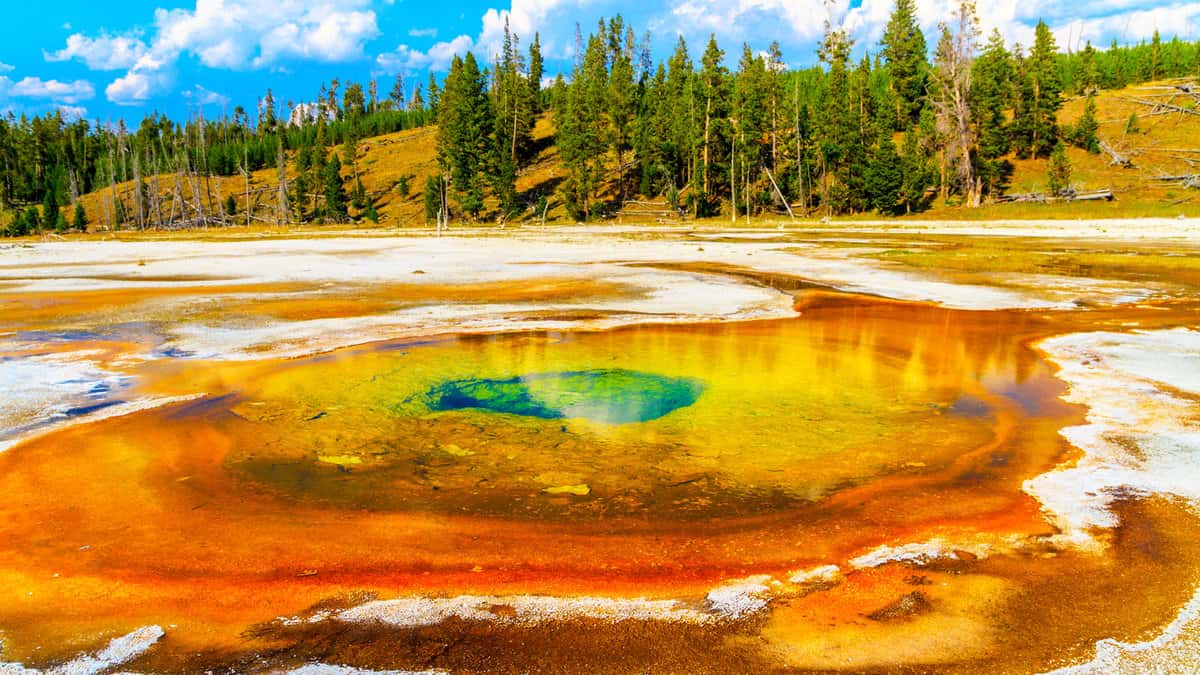
This means the eruption would produce more than 1,000 cubic kilometers of volcanic material, several orders larger than the largest volcanic eruptions in recorded history.
Supervolcanoes are characterized by large magma chambers, which can be several times larger than regular volcanoes.
When a supervolcano erupts, it can cause the ground above the magma chamber to collapse, forming a large depression called a caldera.
The Science Behind Supervolcanoes
Supervolcanoes are typically found at the boundaries between tectonic plates, where magma from the mantle rises to the surface.
The pressure from the overlying rock causes the magma to become trapped in a large chamber beneath the surface, where it can accumulate for thousands of years.
When the pressure in the magma chamber becomes too great, the magma can erupt in a catastrophic explosion. The eruption can produce a massive ash cloud covering entire continents and cause a "volcanic winter" lasting for years.
Despite their destructive potential, supervolcano eruptions are relatively rare, occurring only once every few hundred thousand years.
However, the effects of a supervolcano eruption can be felt for centuries or even millennia, making them a significant threat to human civilization.
Yellowstone's Top 3 Geologic Features
Yellowstone National Park's unique geology results from millions of years of volcanic activity, tectonic movements, and erosion.
In this section, we'll explore the geology of Yellowstone and the different geological features that make it such a fascinating place to visit.
1. Yellowstone Caldera
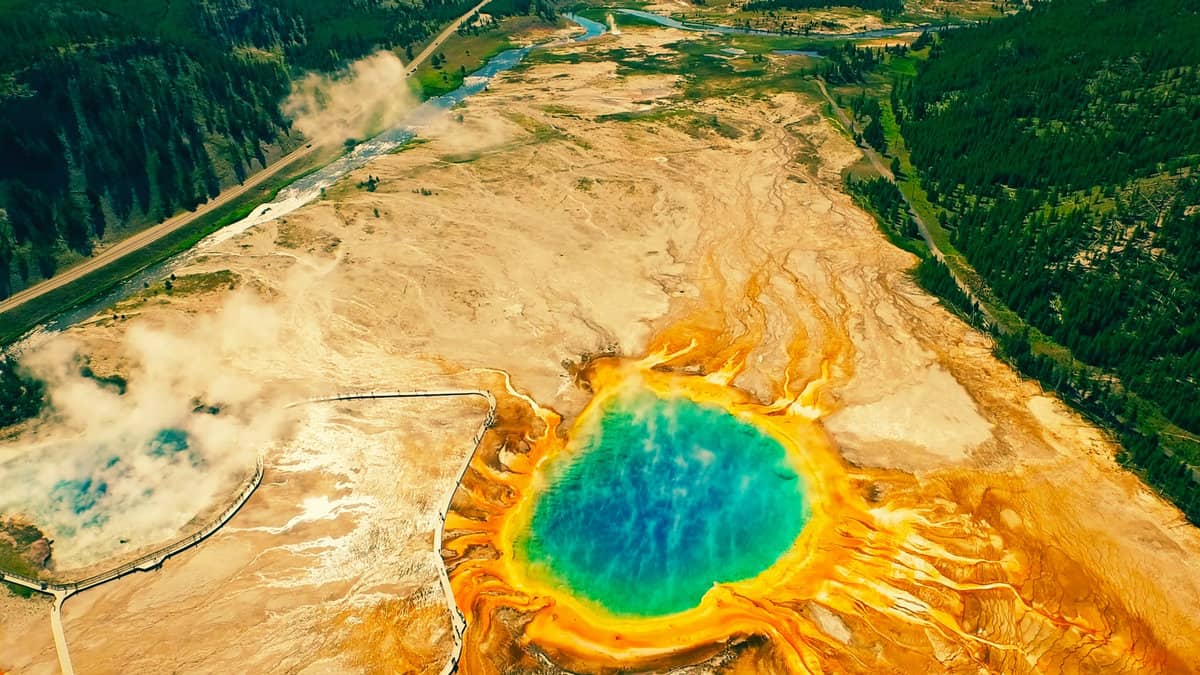
At the heart of Yellowstone's geology is the Yellowstone Caldera, a massive volcanic crater that measures approximately 30 by 45 miles.
The caldera was formed around 640,000 years ago during a massive volcanic eruption spewing ash and lava across the region. Today, the caldera is still active and is closely monitored by the Yellowstone Volcano Observatory.
2. Geysers and Hot Spots
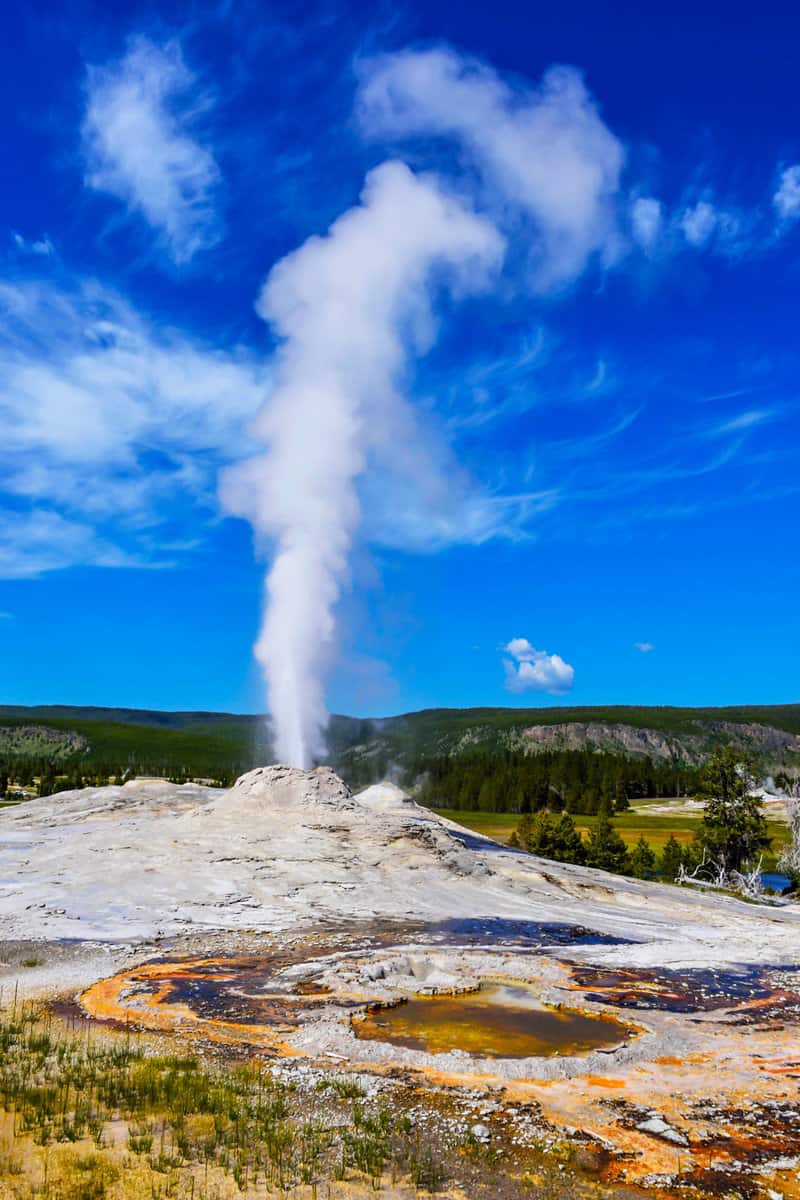
Yellowstone is also home to over 10,000 hydrothermal features, including geysers, hot springs, and mud pots.
These features result from hot spots in the Earth's crust that heat the groundwater and cause it to surface. The most famous of these features is Old Faithful, a geyser that erupts approximately every 90 minutes.
3. Tectonic Activity
The park experiences thousands of earthquakes yearly, most of which are too small to be felt by humans.
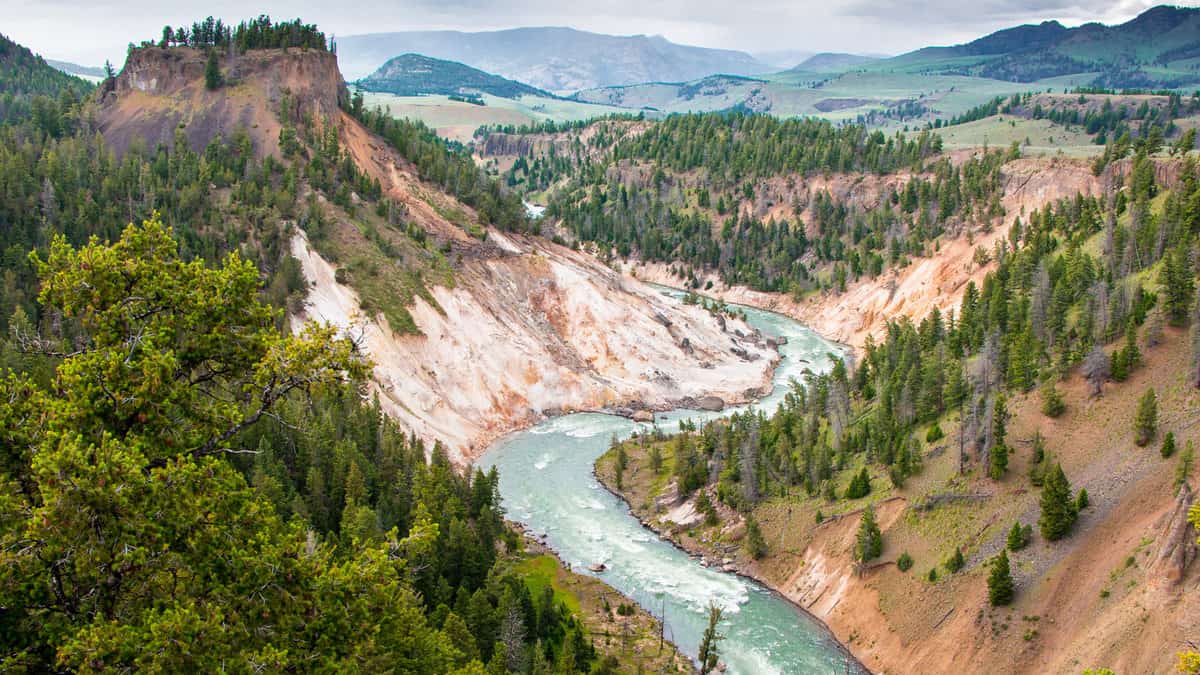
However, some earthquakes can be felt and have caused damage to buildings and roads in the park.
In addition to earthquakes, the tectonic activity in Yellowstone has also led to the formation of mountains, valleys, and other geological features.
One of the most impressive features is Yellowstone Lake, formed by the movement of the Earth's crust.
Debunking the Myths on the Yellowstone Supervolcano
Yellowstone's supervolcano is a fascinating geological feature that has captured the imagination of people worldwide.
Unfortunately, it has also been the subject of many myths and misconceptions. This section will debunk some of the most common myths associated with the Yellowstone supervolcano.
Myth #1: The Yellowstone supervolcano is overdue for an eruption.
This is a common misconception that various media outlets have perpetuated.
The truth is that while the Yellowstone supervolcano is active, it is not overdue for an eruption.
According to the University of Utah, the chances of a catastrophic eruption occurring in any given year are around one in 730,000.
In other words, the chances of an eruption occurring in your lifetime are very low.
Myth #2: An eruption of the Yellowstone supervolcano would be the end of the world.
While an eruption of the Yellowstone supervolcano would undoubtedly be a catastrophic event, it would not end the world.
According to National Geographic, a supervolcano eruption would cause widespread destruction and could significantly impact global climate.
However, it would not be powerful enough to wipe out all life on Earth.
Myth #3: Native Americans feared Yellowstone because of the supervolcano.
This is a persistent myth that historians and archaeologists have debunked.
While Native Americans did have a healthy respect for the power of nature, there is no evidence to suggest that they were afraid of Yellowstone precisely because of the supervolcano.
Many Native American tribes have a deep spiritual connection to the land and view it as a sacred place.
Yellowstone Volcano's Most Epic Historical Eruptions
Yellowstone's supervolcano has a long history of eruptions that have shaped the region's landscape. In this section, we will take a closer look at the significant Yellowstone eruptions and their effects.
Major Yellowstone Eruptions
Yellowstone has experienced three significant eruptions in the past 2.1 million years, each creating a giant caldera within or west of Yellowstone National Park.
The first eruption occurred about 2.1 million years ago, followed by another approximately 1.3 million years ago. The most recent eruption, which occurred about 631,000 years ago, was the largest and most explosive of the three.
The last eruption was not a single explosion but a series of eruptions or multiple vents spewing enormous volumes of hot, fragmented volcanic rocks outward as pyroclastic density currents over vast areas.
The eruption produced a massive amount of ash, which covered much of western North America. The ashfall was so thick that it caused complete darkness in some areas, and it took years for the ash to settle.
Effects of Past Eruptions
The effects of past Yellowstone eruptions have been significant and far-reaching. The ash and pyroclastic flows from the eruptions have affected the climate, causing global cooling and mass extinctions.
The ash has also affected the soil, making it more fertile, and has contributed to forming the region's unique geology.
The lava flows from past eruptions have created the basalt plateaus and canyons visible throughout the park.
The calderas left behind after the eruptions have become hotspots for geothermal activity, producing geysers, hot springs, and other hydrothermal features.
Monitoring Yellowstone's Activity
The Yellowstone Volcano is closely monitored by the United States Geological Survey (USGS) and the Yellowstone Volcano Observatory (YVO), a consortium of 9 member agencies.
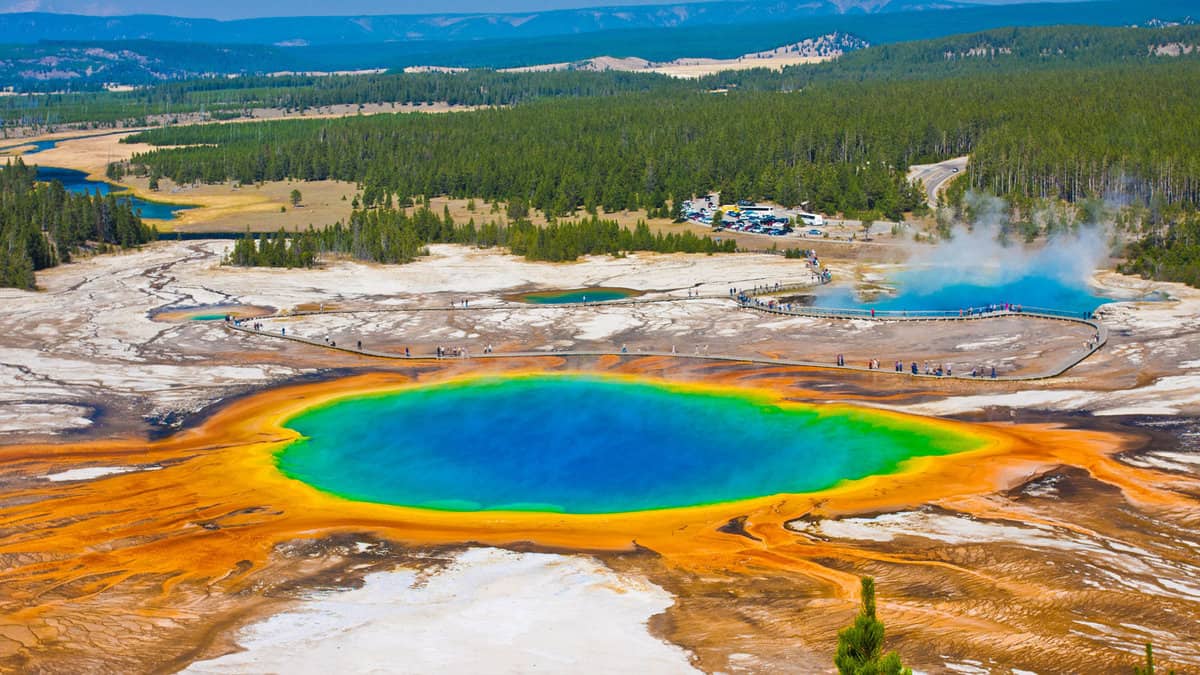
Understanding the science behind monitoring Yellowstone's activity can help dispel myths and misconceptions surrounding the supervolcano.
USGS and Yellowstone Volcano Observatory
The USGS monitors and assesses natural hazards such as earthquakes, landslides, and volcanoes. The Yellowstone Volcano Observatory (YVO) is a partnership between the USGS, the University of Utah, and the National Park Service.
YVO provides timely monitoring and hazard assessment of volcanic, hydrothermal, and earthquake activity in the Yellowstone Plateau region.
YVO's website provides real-time data for earthquakes, ground deformation, streamflow, and selected stream temperatures.
Ground Deformation and Seismic Activity
One of the key indicators of volcanic activity is ground deformation, which refers to changes in the shape or elevation of the ground.
GPS receivers and tiltmeters are used to measure ground deformation at Yellowstone. Seismic activity is another important indicator of volcanic activity.
Seismometers are used to detect earthquakes, which can be caused by magma movement or rock fracturing.
According to the Volcano and Earthquake Monitoring Plan for the Yellowstone Caldera System, 2022-2032, YVO plans to improve the monitoring of hydrothermal areas to better understand these dynamic systems and their associated hazards.
Hydrothermal features, such as geysers and hot springs, are an essential part of Yellowstone's unique ecosystem, but they can also pose a hazard to visitors.
Potential Future Eruptions
Yellowstone National Park's supervolcano is one of the most closely monitored in the world, with scientists watching its every move. This section will explore the potential for future eruptions and their potential impact.
Predicting the Next Eruption
Scientists use various methods to predict when the next eruption will occur, including monitoring the volcano's seismic activity, measuring changes in ground deformation, and analyzing the composition of gases emitted from the volcano.
While these methods can provide valuable insights into the volcano's behavior, they are not foolproof, and predicting the exact timing of an eruption remains a challenge.
According to a recent report by USGS, "Although another catastrophic eruption at Yellowstone is possible, scientists are not convinced that one will ever happen."
Impact of a Major Eruption
A major eruption at Yellowstone could have devastating consequences for the surrounding region and beyond.
If an eruption were to occur today, it could significantly impact the climate, potentially lowering global temperatures by several degrees Celsius.
The eruption could also lead to widespread destruction of crops and wildlife and damage to infrastructure and property in the surrounding states of Wyoming, Idaho, and Montana.
In addition to the immediate effects of the eruption, there could also be long-term consequences, such as the release of large amounts of carbon dioxide and other greenhouse gases into the atmosphere, which could contribute to further climate change.
Despite the potential for a major eruption, the vast majority of volcanic activity at Yellowstone is relatively minor and poses little threat to the surrounding region.
While remaining vigilant and preparing for the worst-case scenario is good, there is no need to panic or overreact to the threat of a major eruption at Yellowstone.
Appreciate Yellowstone’s Power, But Don’t Fear the Supervolcano
While the Yellowstone supervolcano holds tremendous destructive potential, there are good reasons to appreciate this geological wonder instead of fearing it.
This powerful natural phenomenon has shaped the breathtaking landscape we enjoy in Yellowstone National Park today.
Understanding the science behind the supervolcano dispels many myths and unnecessary panic. The volcano also provides an unparalleled natural laboratory for advancing our knowledge of geology.
By continuing to closely monitor Yellowstone's activity through robust networks of GPS, seismographs, and other equipment, scientists are getting better at understanding the sleeping giant.
While we must remain prepared, no imminent threat is on the horizon.
So appreciate the raw power and beauty of the Yellowstone supervolcano, but don't fall victim to the myths. Instead, stay up-to-date on the latest science and discoveries from this landscape of wonders.
The more we learn about Yellowstone’s past eruptions and activity cycles, the better we can protect ourselves for the future while still enjoying all this incredible natural area.
Are you hungry for more Yellowstone facts? Check out:
Witness the World’s Tallest Active Geyser: Steamboat Geyser in Yellowstone
Yellowstone’s Mammoth Hot Springs: The Largest Carbonate-Depositing Spring in the U.S.
Red Lodge, Montana: Gateway to Yellowstone’s Beartooth Pass
Yellowstone River: The Longest Undammed River in the Contiguous United States

I have visited Yellowstone at least 4 times and have always been amazed by it’s total beauty and the awesomeness of the geysers, animals and total overall landscape. Would love to visit one more time however not sure I would make it there and back to my Ozarks. I’m 76 and a widow.
Thoroughly enjoyed reading this article about Yellowstone. The Park Rangers are very good about explaining the features of the Park.
Merry🎄Christmas